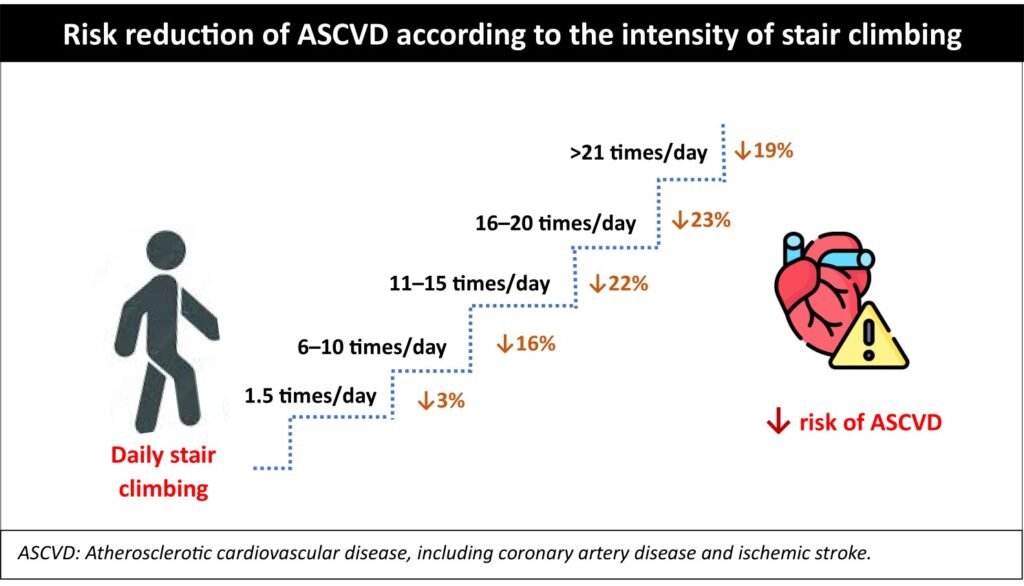
Globally, over 25% of the adults do not meet the recommended physical activity levels advocated for better cardiovascular health. Common barriers to physical activity include health issues, limited resources, financial constraints, and time scarcity. One practical solution to engage in physical activity is integrating stair climbing in daily routine and replacing elevators for short-to-medium distances without significantly affecting the time commitments.
A recent study by Song et al., published in the journal, “Atherosclerosis”, reported that climbing approximately 50 steps daily lowered the risk of atherosclerotic cardiovascular disease (ASCVD), irrespective of the disease susceptibility.
This large-scale prospective cohort study included 4,58,860 adult participants aged 38–73 years from the UK Biobank. Information on medical history and sociodemographic and lifestyle factors was collected using questionnaires at baseline between 2006 and 2010 and a resurvey was carried out at 5 years after the baseline. The participants underwent testing for blood pressure, lung function, and anthropometry, as well as blood analysis for examination of lipids and other related measurements. Information on the intensity of stair climbing was collected through a self-reported structured questionnaire using a 30-day recall method. The study examined the association between regular stair climbing (flight of stairs including approximately 10 steps), including changes over a 12.5-year follow-up period, and the risk of ASCVD (coronary artery disease [CAD], ischemic stroke [IS], and associated acute complications) by estimating the hazard ratio and its confidence interval (CI) using Cox proportional hazard models. The study also examined how these associations might vary depending on an individual’s susceptibility to ASCVD.
The study results are summarized below:
- A total of 39,043 ASCVD cases were recorded over a median follow-up of 12.5 years (CAD: 30,718 and IS: 10,521).
- The ASCVD risk significantly decreased for those who climbed stairs more than 5 times per day, with a 2% lower incidence of ASCVD for each five-times increment in stair climbing. This benefit was consistent across ASCVD subtypes. Risk reduction for ASCVD according to the intensity of stair climbing is highlighted in the Graphic.
- According to disease susceptibility factors (genetic risk scores, 10-year ASCVD risk, family history of ASCVD), the protective association of stair climbing decreased as disease susceptibility increased.
- The associations were generally more pronounced in females (HR 0.97; 95% CI 0.96–0.99), current smokers (HR: 0.96; 95% CI 0.94–0.98), participants with lower body mass index (HR: 0.98; 95% CI 0.96–0.99), and those with hypertension (HR: 0.98; 95% CI 0.97–0.99).
- Participants who initially climbed stairs but stopped at a later stage (at the time of resurvey) had a 32% higher risk of ASCVD compared to those who did not climb stairs regularly (<5 times/day).

Clinical implications
- This study highlights the positive impact of stair climbing on reducing ASCVD risk and its potential to benefit individuals across different disease susceptibility profiles.
- Choosing to climb stairs over elevators for short-to-medium distances can have a significant impact on cardiovascular health outcomes.
- Short bursts of high-intensity stair climbing offer a time-efficient means to enhance cardiorespiratory fitness and improve lipid profiles, making it an accessible strategy to promote physical activity and combat cardiovascular disease.
(Source: Song Z, Wan L, Wang W, Li Y, Zhao Y, Zhuang Z, Dong X, Xiao W, Huang N, Xu M, Clarke R, Qi L, Huang T. Daily stair climbing, disease susceptibility, and risk of atherosclerotic cardiovascular disease: A prospective cohort study. 2023. Doi: https://doi.org/10.1016/j.atherosclerosis.2023.117300)
